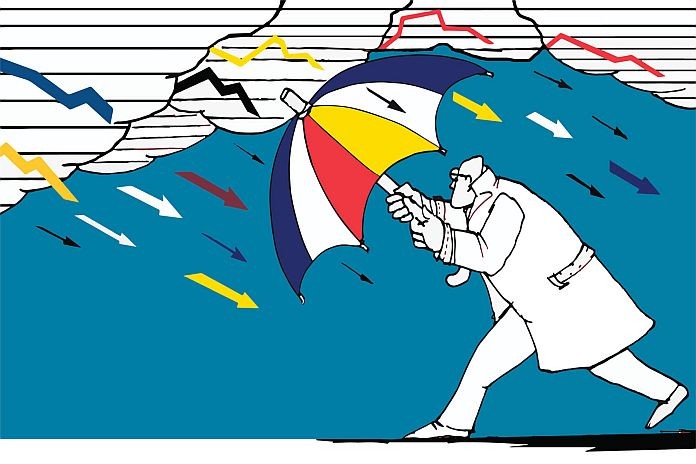-
- With the right tools, policymakers can help to manage the climate risks impacting economies and financial systems
By Tobias Adrian, Vikram Haksar, and Ivo Krznar
When it comes to the devastating impact of climate change, most people think of the harm inflicted on lives and livelihoods. Yet the effects of more frequent and extreme weather are just as consequential for the health of financial systems.
The physical impacts of climate-related shocks, such as hurricane damage to power grids, affect financial institutions and how they make decisions. So do the risks of transition to a low-carbon economy. Think of the costs of new carbon taxes or new laws that require phase-outs of fossil fuels before greener replacements are available.
To make well-informed decisions about future operations, banks, insurers, and others in the financial sector need tools to manage climate risks in their operations and balance sheets. At the same time, as financial supervisors monitor the resilience of the system, they need tools to adequately assess and supervise these risks.
Financial risk analysis
With the right tools, financial sector authorities can start to assess climate risks as a crucial input to gauging how to manage them with the right policies.
This is where the IMF comes in. The Fund’s Financial Sector Assessment Program already regularly examines the resilience of banks and other institutions, including with stress tests to better gauge systemic risks. These procedures are being retooled to incorporate climate risk analysis to better gauge financial stability risks from climate change.
Risk analysis typically entails development of scenario-based stress tests for assessing bank solvency. The process incorporates adverse macroeconomic scenarios specifically designed for the tests – including elements like economic contraction, rising unemployment, exchange-rate shocks, and falling asset prices.
These scenarios are then used as inputs when looking at relationships between these macro drivers and risk factors, such as credit risk and interest income, to estimate impacts on bank income and capital. Bank resilience is then assessed based on whether capital levels fall below regulatory thresholds.
Beyond the standard approach
Unlike conventional stress testing, climate risk analysis, at this stage, doesn’t focus on quantifying possible capital needs of financial institutions relative to the regulatory thresholds. Instead, the IMF approach focuses on measuring and raising awareness of risks. This reflects new challenges, including the complexities of modeling climate risk and its economic impacts over very long horizons and major data gaps.
While the consequences of climate change will play out over decades, risks that could arise in the next three to five years are considered in typical stress testing exercises. The incidence and impact of extreme events is rising and there is sizable uncertainty over policies. All these can potentially have large effects on the value of companies, and thus banks, as markets price in the effects of longer-term risks on business prospects.
The first step in the IMF’s climate risk analysis is to assess which hazards are the most relevant for a country. Where climate risks are important, the bank solvency stress testing framework incorporates the physical and transition risk.
This often starts with temperature and emissions scenarios based on figures from the United Nations Intergovernmental Panel on Climate Change and adapted by the Network for Greening the Financial System, a coalition of central banks working on climate change.
Climate scenarios then map emissions and temperature scenarios to physical risks, like extreme weather, and transition risks, such as future carbon taxes. These scenarios point to the trade-offs between physical and transition risk – the more orderly the transition, the lesser the increase in temperatures and the occurrence of physical climate risk.
Data and projections
The overall assessment of bank stability involves measuring how physical or transition risks impact the economy and bank capital. Physical risks are localized and require new approaches to understanding where storms and floods may strike. The analysis uses new data and projections of the likelihood and impact of different hazards on physical assets like buildings or infrastructure, and economic activity, such as extreme heat that reduces working hours. This approach was applied to consider risks to banks from typhoons in the 2021 Philippines FSAP.
Policies to support transition to a lower carbon world seek to shift resources from brown to green sectors, impacting the prospects for the brown sectors. For the purposes of analyzing how this impacts the financial sector, we assess the impact of carbon taxes (as a proxy for the wide set of policies to foster transition) on individual economic sectors and, where possible, directly on firms’ balance sheets and therefore to banks.
We also assess what happens if investors reassess the value of businesses because of the effect of unforeseen changes in policies on long term earnings. Such an outcome, sometimes referred to as a climate Minsky moment, could lead to increases in credit risk today, affecting bank capital. This was discussed in this year’s United Kingdom FSAP which gauged how firm valuations, and thus credit risk, could be suddenly affected by climate change.
Enhancing the policy framework
At this early stage, climate risk analysis can help raise awareness around the prudent management of climate risks and incentivize banks in improving their frameworks. At the same time, it will help to inform supervisors about the potential magnitude of climate-related risks in their jurisdictions and better understand transmission channels to the financial system.
Currently, several supervisors and central banks use climate stress tests to measure the exposures to related risks. This helps to understand the challenges to banks’ business models, the implications for the provision of financial services, and desired policy responses. Ultimately, climate risk analysis will help financial institutions disclose and manage related risks.
—This blog reflects research by Pierpaolo Grippa, Marco Gross, Sujan Lamichhane, Caterina Lepore, Fabian Lipinsky, Hiroko Oura and Apostolos Panagiotopoulos.
![]()





